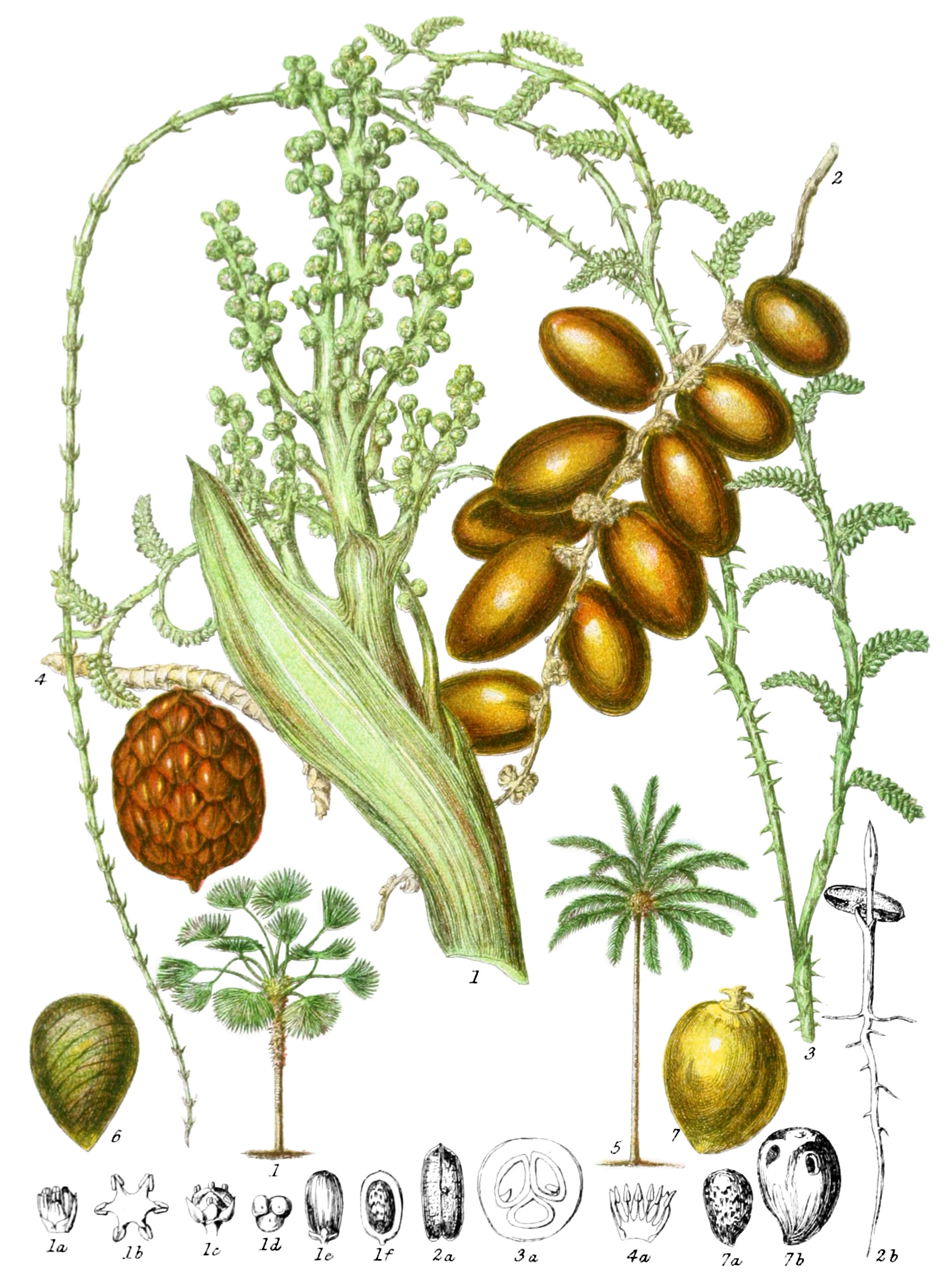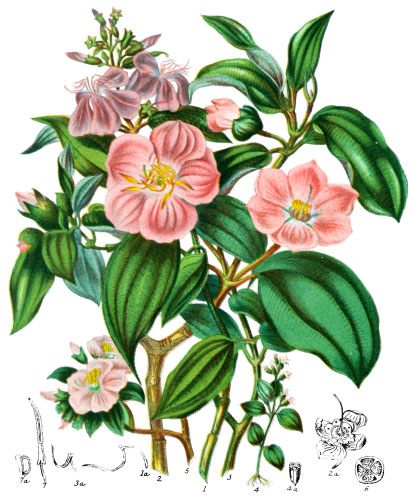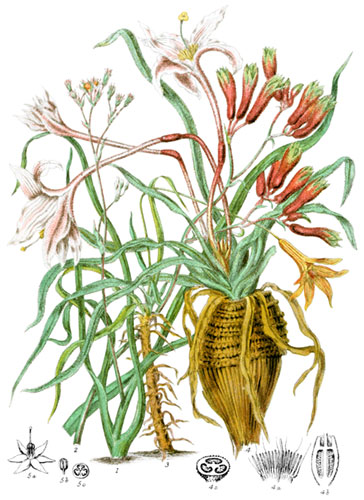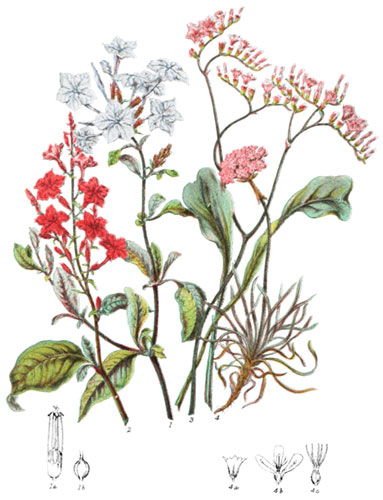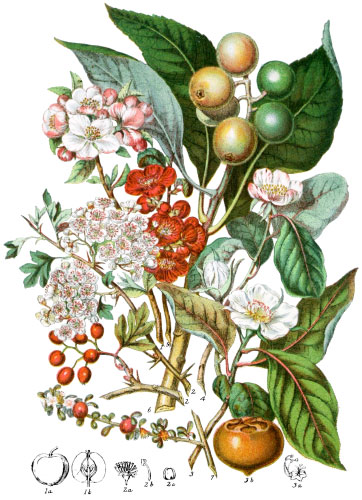Key characteristics
Trees with a simple stem, occasionally branching shrubs, rough with the bases of the leaf-stalks or their scars. Calamus has a long slender stem, sometimes armed with spines. The leaves are in clusters, terminal, usually very large, pinnate, plaited, fan-shaped, with parallel simple veins; sometimes wedge-shaped. The flowers are on a terminal scaly spadix, enclosed in a single or many-valved spathe, which is often woody. The flowers are small, having scaly bracts; the stamens and pistil are usually separate. The sepals are three, fleshy or leathery, persistent; the petals are three, the stamens inserted into the base of the corolla, usually six, seldom there. The ovary is free, usually composed of three carpels completely or partially united; the styles three. The fruit is a drupe, nut, or berry, often having a fibrous rind. The seed fills the cavity in which it grows, and contains cartilaginous albumen, in which is the embryo, its place indicated by a small swelling on the back of the seed (2a).
This Tribe has slight affinity with Pandanaceæ.
Oil, wax, farina, sugar, and salt exist in these trees.
Select plants in this order
Not all plants listed are illustrated and not all plants illustrated are listed.
- Palms have received the highest admiration in all ages: inspired writers have taken a Palm as an emblem of prosperity, and a symbol of victory. Botanists have bestowed on them the noblest titles, and they are unrivalled in the vegetable world, in simpler grandeur of form, and for their varied and extensive utility to man, especially in the countries where they flourish. The first mention of them in Scripture, is when Moses, having led the Israelites through the Red Sea, they encamped under the shade of seventy Palm-tres. From the earliest times Palms have, without cultivation, furnished everything necessary to the existence of the natives: excellent materials for dwellings, cordage of all kinds, clothing, food, and many other valuable substances. The strong fibres which bind the base of the leaf-stalk to the stem are available in various ways; few European ships leave the Brazilian coast without a store of Palm fibres. Some, which are tough, bristle-like, are made into strong brooms, now almost superseding those made of Birch twigs.
- The fibrous exterior of the Cocoa-nut Palm is woven into the classic Coir rope, one of the best materials for cordage and mats.
- Chamærops (1), is the only Palm advancing into Europe, growing on the south coast, in N. lat. 44°. In Morocco it covers the hills like brushwood; in England it requires the shelter of a conservatory, where it bears countless flowers, but not fruit.
- C. Palmetto extends to the northern limit of the race in N. America, to 36° N. lat.
- Phœnix dactylifera (2) is a wonderful example of fertility, affording the chief supply of food to the people of Northern Africa and Arabia. A single spathe contains 12,000 stamen flowers, and the cluster of fertile flowers produces a prodigious quantity of fruit. The sap of the stem is obtained by cutting off the crown, as in other Palms, and is highly esteemed as a beverage.
- The spathe of Alfonsia has been reckoned to contain 200,000 flowers; and each cluster of a Palm of the Orinoco bears 8000 fruit.
- Calamus, the Rattan, is of peculiar growth, partly resembling the Bamboo; the leaves secreting silex also connects this Tribe with Grasses. Instead of a columnar stem, it has a long, round, jointed stem, in some instances 500 feet in length, stretching like cables over trees, rendering the jungles almost impenetrable. The leaves are pinnated, of most graceful form, the leaf-stalk often prolonged to one or two feet, as in C. palustris (3). This genus ascends to 6000 feet on the outer range of the Himalaya.
- Plectocomia likewise climbs over tall trees.
- A large supply of Sago is obtained from the pith of Sagus Rumphii (4), the fruit of which is sometimes brought to this country, although useless.
- S. lævis and S. genuina grow in dense forests in the Moluccas, yielding an abundant pith for Sago.
- One of the most valuable and beautiful Palms is Cocos nucifera (5), fringing on the coasts of the isles of the Chinese Sea, Indian Ocean, and Pacific. In Ceylong, groves of Cocoa-nut Palms border the shore for thirty miles; they live a century, bearing each month as many as fourteen nuts, and yielding as much oil as an Olive-tree. The fibres make excellent cordage, and serve countless useful purposes to the natives and Europeans.
- The fruit of Phytelephas (6) is of a fine white texture, and is worked like ivory. Since the formation of railroads, the necessary use of grease for wheels has been extreme; but the stores of vegetation are unlimited, and the power of commerce, in transporting abundance wherever needed, is unbounded.
- On the cost of Guinea are groves of Elais Guineensis (7), yielding plentifully an oily substance of a bright yellow colour, admirably adapted for carraige-wheels, and also for soap and candle manufacture. Besides this value, a still higher interest belongs to it, as the British ships frequenting the coast to bring it away have been a means of greatly diminishing the traffic in slaves, who were collected and kept in huts on the shore.
- Corypha, the noble Fan Palm, belongs to the East Indian Islands; the gigantic leaves are six feet long and fifteen wide, undivided into 100 segments at the edges, of much value in thatching, and for umbrella-like hats. The stems of some are marked with a black spiral line, indicating the position of former leaves.
- The fruit of Areca Catechu is the Betel, indispensable to nearly all Asiatics.
- Hyphæne Thebaica, the celebrated Doom Palm of Egypt, has a branching, forked stem.
- Ceroxylon andicoloa is found on the Andes, at 9000 feet, in the region of Quito; a resinous wax exuding from its stem of 180 feet, is used for candles by the miners.
- Mauritia, Iriartea, and other Palms, abound on the lower elevations of the Andes.
- In a former period of the world, Palms appear to have existed abundantly at the mouth of the Thames.
Locations
This extensive Tribe is dispersed most abundantly in the Tropics of Asia and America, on the humid banks of rivers, on the shores of the ocean, on lofty mountains, and on plains. The limits of its range are 36° N. lat. in N. America and 38° S. lat. in New Zealand.
Legend
- Chamærops humilis, Dwarf Palm. South Europe.
- Stamen Flower.
- Stamens.
- Fertile Flower.
- Ovaries.
- Fruit.
- Section.
- Phœnix dactylifera, Date Palm. Levant.
- Seed.
- Sprouting.
- Calamus palustris, Rattan Palm. E. Indies.
- Sagus Rumphii, Sago Palm. E. Indies.
- Flower, opened.
- Cocos nucifera†, Cocoa-nut Palm. I. Isles.
- Phytelephas macrocarpa. Ivory-nut Palm. Peru.
- Fruit of Elais.
- Seed.
- Fruit without the bulb.
-
- Section of Palm fruit.
- *Section of Palm fruit was labeled as 3a in the original illustration but 8a in the original text.
- † Cocos nucifera was spelled “Cocus nucifera” in the original description.
Explore more
Posters
Decorate your walls with colorful detailed posters based on Elizabeth Twining’s beautiful two-volume set from 1868.
Puzzles
Challenge yourself or someone else to assemble a puzzle of all 160 botanical illustrations.
